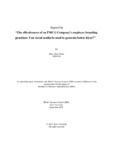The effectiveness of an FMCG Company’s employer branding practices: Can social media be used to generate better hires?

View/
Date
2022-09Publisher
Brac UniversityAuthor
Tanha, Esha AlamMetadata
Show full item recordAbstract
Nestlé started its journey back in 1866 when Henry Nestlé created the world’s first effective
breastmilk replacement formula. The organization has gone through two world wars and evens
some major controversies during its 156 years of history, and is currently one of the leading
Fast Moving Consumer Goods (FMCG) companies of the world.
Nestlé has been operating in Bangladesh since the 1990’s, beginning as a joint venture in 1992
and being formalized as a wholly owned subsidiary in 1998, with its current headquarters
located at Tejgaon Industrial Area, Dhaka. For nearly three decades, Nestlé Bangladesh
Limited has been offering Bangladeshi consumers a diverse range of products across multiple
segments, including dairy, coffee and beverages, instant food items, infant nutrition, breakfast
cereals, and confectionary items.
The company generally practices a democratic leadership style, where the decision-making
process involves engaging with subordinates and taking their inputs and concerns into account.
Among its employees, the company encourages a culture of learning, which is supported by a
number of training and development initiatives focused on growing both soft and hard skills.
As for recruiting said employees in the first place, Nestlé has separate hiring processes in place
depending on whether they’re hiring interns, entry-level employees, or mid-level and upper level managers. The compensations structure generally follows a pay mix including base pay,
allowances, incentives, as well as the incorporation of benefits such as insurance and PTO.
While Nestlé’s marketing strategy and target customers are extremely diverse, given the
diversity of product segments it operates in. In essence, almost everyone but the ultra-elite and
the poverty-stricken are target customers of the company, and it uses whatever marketing
strategy is relevant to each brand, product, and specific target segment. The company also has
a track record of excellent advertising practices, and continues to win awards for them.
Nestlé’s operations management structure is quite organized, with both the supply chain and
distribution chain being segmented into appropriate functions. The company’s IT practices are
however quite simple, and mostly include common documentation and communication tools
from Microsoft. The organization operates in a moderately-highly competitive environment,
and its global financial state is one that is heavily debt-leveraged but quite profitable. A
dedicated platform is however used by the sales department for keeping track of sales,
inventory, and distribution information.
The FMCG sector that Nestlé operates in is one that is moderately high in terms of overall
competition. While threat from new entrants is extremely low due to the high financial barrier
to entry, threats from substitute goods and existing rivalry is quite high, along with supplier
bargaining power, and bargaining power of customers is extremely high. Nestlé’s strengths
mostly include brand image, infrastructure, and intellectual property, while weakness are
mainly a controversial history and high costs. It has the opportunity to tap into new e-commerce
marketplace, while facing the threat from increased competition.
In the research project chapter, social media-based employer branding in the FMCG sector has
been explored through a qualitative study. Although the existing body of literature suggest that
employer branding should lead to higher employee performance and lower employee turnover,
the findings of the study do not agree with this premise. The most likely causes behind the
disagreement are theorized to either be a gap in the employer branding being implemented, or
the existence of unobserved external factors. It is highly unlikely that the existing body of
knowledge is flawed, since a wide range of authors agree on the premise, and as such, the issue
with the results must lie elsewhere.
